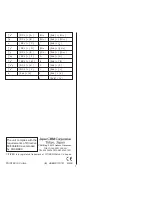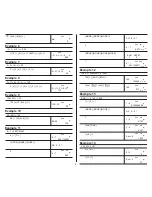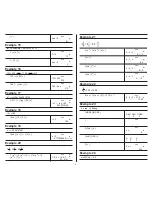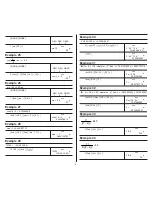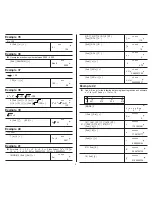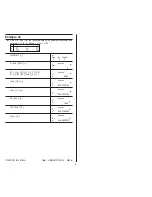
3
Stack
This calculator uses memory areas, called “ stacks “, to temporarily
store values (numeric stack) and commands (command stack ) accord-
ing to their precedence during calculations. The numeric stack has 10
levels and command stack has 24 levels. A stack error (Stk ERROR)
occurs whenever you try to perform a calculation that is so complex that
the capacity of a stack is exceeded.
Order of operations
Each calculation is performed in the following order of precedence :
1)
Coordinates transformation.
2)
Type A functions which are required entering values before
pressing the function key, for example, x
2
,
, x !, x
–1
.
3)
y
x
,
x
.
4)
Fractions.
5)
Abbreviated multiplication format in front of variables,
π
.
6)
Type B functions which are required pressing the function key
before entering, for example, sin, cos, tan, sin
–1
, cos
–1
,
tan
–1
, sinh, cosh, tanh, sinh
–1
, cosh
–1
, tanh
–1
, log, ln, 10
X
,
e
X
,
,
3
, ( – ).
7)
Abbreviated multiplication format in front of Type B functions
3
2
, Alog2, etc.
8)
nPr, nCr
9)
x ,
÷
10) +, –
• When functions with the same priority are used in series,
execution is performed from right to left.
e
X
ln120
→
e
X
{ ln (120 ) }
otherwise, execution is from left to right.
• Compound functions are executed from right to left.
• Anything contained within parentheses receives the highest
priority.
Accuracy and Capacity
Output digits : Up to 10 digits.
Calculating digits : Up to 15 digits
In general, every reasonable calculation is displayed up to 10 digits
mantissa, or 10-digits mantissa plus 2-digits exponent up to 10
± 99
.
Numbers used as input must be within the range of the given function as
follow :
Functions
Input range
sin x, tan x
Deg : 0 < l x l
< 4.499999999 x 10
10
Rad : 0 < l x l
< 785398163.3
Grad : 0 < l x l
< 4.499999999 x 10
10
however, for tan x
Deg : | x |
≠
90 (2n–1)
Rad : | x |
≠
2
π
(2n–1)
Grad : | x |
≠
100 (2n–1) ( n is an integer)
cos x
Deg : 0 < l x l
< 4.500000008 x 10
10
Rad : 0 < l x l
< 785398164.9
Grad : 0 < l x l
< 5.000000009 x 10
10
sin
-1
x, cos
-1
x
0 < l x l
< 1
sinh x, cosh x
0 < l x l
< 230.2585092
tan
-1
x
0 < l x l
< 9.999999999 x 10
99
tanh x, tanh
-1
x
0 < l x l
< 9.999999999 x 10
– 1
sinh
-1
x, cosh
-1
x
0 < l x l
< 4.499999999 x 10
99
log x, ln x
x > 0
10
x
– 9.999999999 x 10
99
< x
< 99.99999999
e
x
– 9.999999999 x 10
99
< x
< 230.2585092
0
<
x < 1 x 10
100
x
2
l x l
<
1 x 10
50
x
–1
l x l
<
1 x 10
100
, x
≠
0
l x l
<
1 x 10
100
x !
0 < x < 69 , x is an integer.
Pol ( x, y )
l x l, l y l < 9.999999999 x 10
49
x
2
+ y
2
<
9.999999999 x 10
99
Rec (r,
θ
)
0 < r < 9.999999999 x 10
99
Deg : 0 < l x l
< 4.499999999 x 10
10
Rad : 0 < l x l
< 785398163.3
Grad : 0 < l x l
< 4.499999999 x 10
10
however, for tan x
Deg : l
θ
l
≠
90 (2n–1)
Rad : l
θ
l
≠
2
π
(2n–1)
Grad : l
θ
l
≠
100 (2n–1) (n is an integer)
l a l , b, c < 1 x 10
100
, 0
< b, c
l x l
<
1 x 10
100
Sexagesimal
↔
Decimal transformation
0
0
0
< l x l
< 999999
59
x
y
x > 0 : – 1 x 10
100
<
y log x < 100
x = 0 : y > 0
x < 0 : y = n, 1/(2n+1), n is an integer.
but – 1 x 10
100
< y log
l x l
<
100







